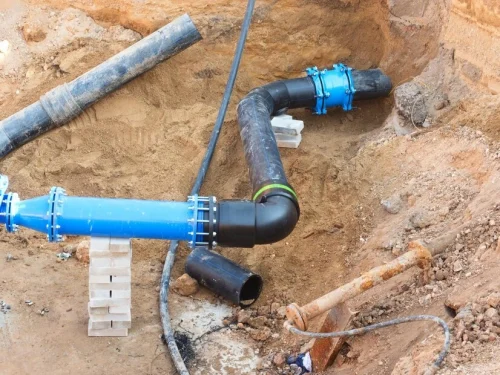
How to Choose the Best Veneer Furniture For Style & Durability
April 18, 2025
Reshape Your Home with Trendy & Different Types of Door and Windows
April 18, 2025When was the last time you thought about what happens after you flush the toilet or drain your sink? Probably never, right? Sewer pipes and underground sewer systems work silently beneath our cities, handling millions of gallons of wastewater every day, yet they remain one of the most overlooked parts of modern infrastructure.
But what if these hidden networks stopped working for just a day? The results would be disastrous: flooded streets, unbearable odors, and serious health risks.
From ancient drainage channels to today’s smart, self-cleaning sewers, the way we manage waste has come a long way. But how exactly do these sewer underground systems work? What keeps them running smoothly despite handling tons of waste daily? And with climate change and urban expansion, how are engineers designing smarter house drainage systems for the future?
Let’s dive underground and uncover the unseen world of modern sewer systems.
How Modern Sewer Systems Work
The underground sewer systems of today have evolved far beyond the rudimentary drainage systems of ancient civilizations. Modern sewers rely on an intricate network of pipes, pumps, and treatment plants to efficiently handle wastewater from residential, commercial, and industrial sources. These systems are broadly categorized into two types:
- Sanitary Sewer Systems: These transport wastewater from homes and buildings to sewage treatment plants. They keep contaminated water separate from stormwater to prevent overflows and pollution.
- Stormwater Drainage Systems: These collect rainwater from roads and open spaces, directing it into natural water bodies or treatment units to prevent urban flooding.
Most house drainage systems use gravity-based flow, where water moves naturally through sloped sewer pipes. However, in areas with low elevation, pumping stations are used to push wastewater to higher ground, ensuring uninterrupted flow. Advanced sewer systems also incorporate sensors and real-time monitoring to detect blockages and optimize maintenance efforts.
Also Read: How to Choose the Right Water Pipes for House Waterworks
Components of an Underground Sewer System
A sewer underground network consists of various essential components, each playing a specific role in wastewater management. Here’s a breakdown of the major elements:
Component | Function | Common Materials |
Sewer Pipes | Carry wastewater from homes and industries | PVC, Concrete, Cast Iron, HDPE |
Manholes | Allow maintenance access to sewer lines | Concrete, Brick, Fiberglass |
Pumping Stations | Move wastewater where gravity flow isn't possible | Steel, Reinforced Concrete |
Catch Basins | Collect stormwater and prevent debris from entering pipes | Cast Iron, Concrete |
Interceptor Sewers | Large pipes that transport sewage to treatment plants | Concrete, Steel |
Sewage Treatment Plants | Process wastewater before releasing it into the environment | Various materials |
Proper installation and maintenance of these components ensure the system functions efficiently without leaks or blockages. Cities invest heavily in durable sewer pipes to prevent costly repairs and environmental hazards.
Challenges and Innovations in Sewer Management
Challenges Facing Sewer Systems
Despite technological advancements, underground sewer systems face several challenges, including:
- Aging Infrastructure: Many cities still rely on century-old sewer underground systems that are prone to leaks, collapses, and inefficiencies.
- Blockages and Overflows: Improper disposal of waste, grease buildup, and tree root infiltration cause frequent blockages in house drainage systems.
- Climate Change and Heavy Rainfall: Increased rainfall can overwhelm combined sewer systems, leading to dangerous sewage overflows.
- Pollution and Contamination: Leakages in sewer pipes can contaminate groundwater and pose serious health risks.
Also Read: PVC vs uPVC: Which is Better?
Innovations in Sewer Technology
To address these issues, modern underground sewer systems incorporate several innovative solutions:
- Smart Sewer Sensors: Cities use AI-powered sensors to monitor pipe conditions, detect leaks, and predict maintenance needs.
- Trenchless Pipe Repair: Techniques like Cured-In-Place Pipe (CIPP) lining allow for non-invasive repairs, extending the lifespan of sewer pipes without digging up roads.
- Green Infrastructure: Sustainable solutions, such as permeable pavements and rain gardens, help reduce stormwater loads on drainage systems.
- Self-Cleaning Sewers: Some new systems incorporate hydraulic cleaning to prevent sediment buildup and minimize maintenance efforts.
These innovations not only enhance system efficiency but also reduce maintenance costs and environmental risks.
The Importance of Sewer Systems in Urban Development
Efficient house drainage systems are critical to urban expansion, public health, and environmental protection. As cities grow, increased demand for sanitation infrastructure requires continuous investment in sewer pipes and drainage solutions.
Here’s why sewer systems remain a cornerstone of urban planning:
- Public Health: A well-maintained sewer underground system prevents waterborne diseases by keeping wastewater separate from drinking supplies.
- Environmental Protection: Proper wastewater management reduces pollution in rivers, lakes, and oceans.
- Economic Growth: Cities with advanced underground sewer systems attract more investment, as businesses prefer locations with reliable infrastructure.
- Flood Prevention: Upgraded house drainage systems help prevent waterlogging, protecting properties from damage.
Urban planners and governments continuously work towards enhancing sewer infrastructure to support sustainable development.
Also Read: How to Stop Water Leakage from the Wall: A Step-by-Step Guide
Conclusion
The vast network of underground sewer systems is a hidden yet vital component of modern civilization. From ensuring sanitation to protecting the environment, sewer pipes and drainage networks play an essential role in urban life. Despite challenges like aging infrastructure and climate change, technological advancements continue to improve system efficiency and sustainability.
As cities expand, investment in advanced house drainage systems is crucial for maintaining hygiene, reducing pollution, and supporting economic growth. Whether it’s smart monitoring, eco-friendly innovations, or durable pipeline materials, the future of sewer underground networks is geared towards resilience and efficiency.
Enhance Your Home with GreenFortune's Premium uPVC Windows and Doors
While underground sewer systems are vital for urban infrastructure, the quality of your home's windows and doors is equally crucial for comfort and energy efficiency. GreenFortune is India's fastest-growing manufacturer of high-quality uPVC windows and doors, offering a range of customizable options to suit your home's aesthetic and functional needs.
Our products are durable, energy-efficient, and designed to withstand various climatic conditions, ensuring long-lasting performance. Transform your living spaces with GreenFortune's innovative solutions today!
FAQs
- What are the best materials for sewer pipes?
The best materials for sewer pipes include PVC, HDPE, concrete, and cast iron, depending on durability and application. PVC is commonly used for residential house drainage systems, while concrete is preferred for large-scale underground sewer systems. Choosing the right material ensures longevity and minimizes maintenance costs. - How often should underground sewer systems be maintained?
Routine inspection and cleaning of sewer underground networks should be conducted every 1-2 years. Regular maintenance helps prevent blockages, detect leaks, and ensure efficient wastewater flow. Advanced monitoring technologies are now available to automate maintenance schedules. - What causes blockages in house drainage systems?
Blockages in house drainage systems are commonly caused by grease buildup, foreign objects, tree root intrusion, and sediment accumulation. Using drain strainers and avoiding flushing non-biodegradable materials can prevent clogs. Regular sewer inspections help identify and resolve potential issues early. - Can smart technology improve sewer systems?
Yes, smart technology enhances underground sewer systems by using sensors to detect leaks, blockages, and flow patterns. AI-driven monitoring systems enable proactive maintenance, reducing operational costs and preventing environmental hazards. Many cities are adopting these innovations for improved efficiency. - How do underground sewer systems support urban development?
Reliable sewer underground networks are essential for urban growth, ensuring sanitation, flood control, and public health. Efficient house drainage systems reduce water pollution and attract business investments. Governments prioritize sewer infrastructure upgrades to sustain expanding populations.







